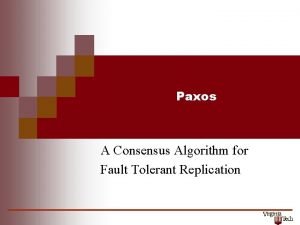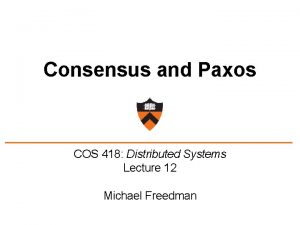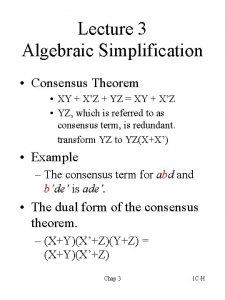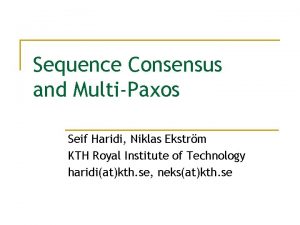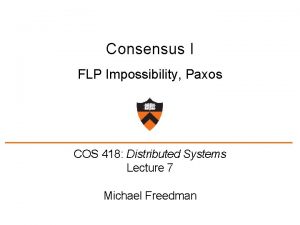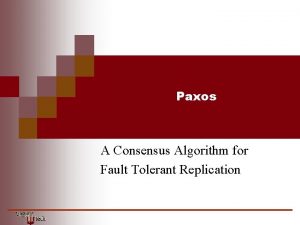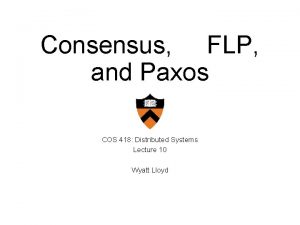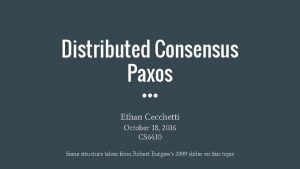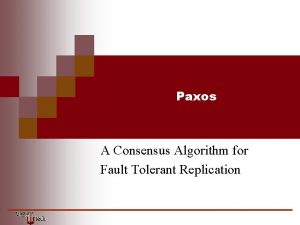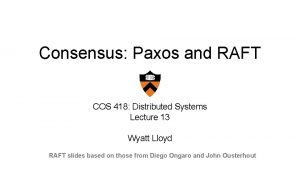Paxos Made Simple Oneshot Paxos solving consensus Multipaxos







![Consensus in an asynchronous environment is unsolvable [FLP 1985] FLP is about liveness But Consensus in an asynchronous environment is unsolvable [FLP 1985] FLP is about liveness But](https://slidetodoc.com/presentation_image_h2/73790bb9f3ea87ab0b0b503ca60f698c/image-8.jpg)


















- Slides: 26

Paxos Made Simple

One-shot Paxos: solving consensus Multipaxos: Efficient state machine replication

One-shot Paxos: solving consensus Multipaxos: Efficient state machine replication

Consensus Get N nodes to agree on a value {false, true} {1, 2, 3, . . . } {“attack at dawn”, “retreat at dawn”}

Let’s get pizza! Let’s get teriyaki! Let’s get burgers!

See you at burgers. Oh, the humanity! See you at burgers.

Consensus Nodes can fail Network is asynchronous
![Consensus in an asynchronous environment is unsolvable FLP 1985 FLP is about liveness But Consensus in an asynchronous environment is unsolvable [FLP 1985] FLP is about liveness But](https://slidetodoc.com/presentation_image_h2/73790bb9f3ea87ab0b0b503ca60f698c/image-8.jpg)
Consensus in an asynchronous environment is unsolvable [FLP 1985] FLP is about liveness But Paxos solves it anyway assume the network is eventually well-behaved

Safety a wrong thing never happens Liveness good things eventually happen the system doesn’t decide a value never proposed two nodes don’t declare different

The Most Important Idea In Distributed Systems The state of a distributed system is: unsynchronized memories in-flight network packets At what commit point can we say that an event occurred? Turns out this question almost always has a discrete answer. Teasing it out is how you understand the distributed behavior.

Consensus Everybody decides on a single value The event is when the value was decided. The commit point is when the value is accepted (and recorded persistently) by a quorum of acceptors.

3, X 3, X 3, X 1, X 3, X 4, X 2, Y 2, Y 4, X

3, X 3, X 3, X 1, X 3, X 4, X 2, Y 2, Y 4, X !decided(X)

A 2 A 3 L 1, X A 1 2, Y 1, X 2, Y 3, Y Decide Y {2: Y, 1: X, 2: Y} Accept 3, Y! Propose 3, Y? Prepare 3! Prepare 3? Propose 2, Y? Prepare 2? {⊥, ⊥} Accept 2, Y! Prepare 2! Accept 1, X! Propose 1, X? P 2 Accept 1, X! Prepare 1! P 3 Prepare 1? P 1 {⊥, ⊥}

Ballots: motivation (Suppose f=2, N=2 f+1=5) We need a quorum for the (obvious) reason that otherwise 2/5 acceptors could accept one value, and 2/5 could accept another, and now consensus has failed. What happens if a quorum (3/5) of acceptors accept a value, and then two of them fail? The commit point has already happened. The value won’t get lost. But how can the rest of the system learn that it has? To get liveness, we need “view change”.

Ballots The key idea for liveness is that one-shot Paxos can run a sequence of ballots, all regarding the same decision. From the outside, we know that some ballot will be the first in which the moment of decision occurred. But from the inside, we need additional ballots to expose that decision

How to maintain the invariant Constrain what values a leader can propose Leader must poll acceptors, and honor any latest value observed. If a value accepted by two acceptors is lost because both failed, that’s okay: it wasn’t decided, either. Prepare reply: Acceptors must promise (record persistently) to never vote in an earlier ballot, so that the invariant doesn’t break by virtue of an

P 1 a. An acceptor can accept a proposal numbered n iff it has not responded to a prepare request having a number greater than n. ==> P 2 c. For any v and n, if a proposal with value v and number n is issued, then there is a set S consisting of a majority of acceptors such that either (a) no acceptor in S has accepted any proposal numbered less than n, or (b) v is the value of the highest-ballot-numbered proposal among all proposals numbered less than n accepted by the acceptors in S. ==> P 2 b. If a proposal with value v is chosen, then every higher-numbered proposal issued by any proposer has value v. ==> P 2 a. If a proposal with value v is chosen, then every higher-numbered proposal accepted by any acceptor has value v. ==> P 2. If a proposal with value v is chosen, then every higher-numbered proposal that is chosen has value v.

One-shot Paxos: solving consensus Multipaxos: Efficient state machine replication

Alice: deposit $20 Bob: withdraw $10 Alice: balance $80 Alice: transfer $5 Bob: denied NSF Alice: transfer OK

Alice: deposit $20 Bob: withdraw $10 Alice: balance $80 Alice: transfer $5 Bob: denied NSF Alice: transfer OK

Alice: deposit $20 , Alice: transfer $5 , Bob: withdraw $10 Decide Alice: transfer $5 Decide Alice: deposit $20 Decide proposals decided inputs [ Bob: withdraw $10 , . . . ] Alice: transfer $5 Bob

Multipaxos Decide each slot in the input sequence separately Can execute through the prefix of decided slots

[ _ , _ , _ Prepare doesn’t , _ , . . . ] epend on values d [ X , Y , W , _ , _ , Pre_pare, who_le ra, nge _ Leader 1 allocates, prepares these slots with one message , _ , . . . ] [ XLeader , 1 Ycommits , Wsome, ops_ , _ , . . . ]. . . and then dies. slots_ [ X , Y , W , _ , Leader _ , 2 allocates, Z , prepares V , these _ , , _ , . . . ] [ X , Y , W , ∅ , Leader ∅ , 2 starts Z , committing V , ops_ , _ , . . . ] … but they can’t execute until these holes are filled! Leader 2 backfills holes with decided values or no-ops

Determinism a practical challenge Make the program deterministic Use PRNGs with consistent seed Can’t call the clock! Time comes from Paxos inputs. All libraries must be deterministic Exposed malloc pointers, exposed hash table fills

Determinism Or, accept a nondeterministic program. Execute it once before consensus and decide on the state update.
 Paxos made simple
Paxos made simple Paxos made simple
Paxos made simple Paxos algorithm
Paxos algorithm Chubby paxos
Chubby paxos Ken birman
Ken birman Paxos lock
Paxos lock Paxos distributed systems
Paxos distributed systems Sayed hadi hashemi
Sayed hadi hashemi Simple present simple past simple future exercises
Simple present simple past simple future exercises Simple past simple present simple future
Simple past simple present simple future Past simple future
Past simple future Present simple present continuous past simple
Present simple present continuous past simple Future simple examples
Future simple examples Present past future simple continuous exercises
Present past future simple continuous exercises Use of has been and have been
Use of has been and have been Simple present afirmativa, negativa e interrogativa
Simple present afirmativa, negativa e interrogativa Future simple present simple
Future simple present simple What are the disadvantages of consensus making
What are the disadvantages of consensus making Washington consensus 10 principles
Washington consensus 10 principles What example does hank green give for social loafing?
What example does hank green give for social loafing? Social facilitaion
Social facilitaion Consensus error grid
Consensus error grid Consensus error grid
Consensus error grid Consensus theorem
Consensus theorem The false consensus effect examples
The false consensus effect examples Consensus model criminal justice
Consensus model criminal justice Consensus model criminal justice
Consensus model criminal justice



